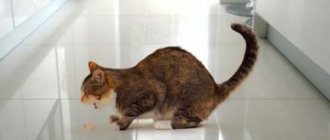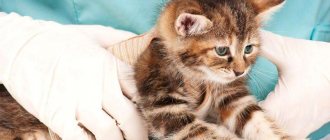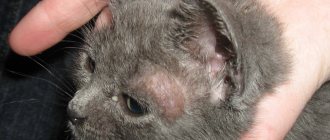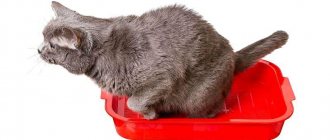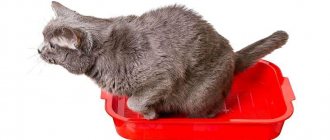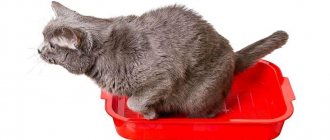All rights to materials posted on the site are protected in accordance with the legislation of the Russian Federation, including copyright and related rights. When using site materials, a link to the source is required
Address: 649002, Altai Republic, Gorno-Altaisk, Kommunistichesky Avenue, 173
Email mail:
Source
Tablets, medicines, deworming drops for cats: when and how to give, names, instructions
Veterinary pharmacies offer a wide range of all kinds of anthelmintic drugs or, as they are commonly called, deworming medications. It is fundamentally important to learn to understand what their fundamental difference is, what the principle of action is and whether the uncontrolled use of such drugs is safe.
The process of removing worms from the body is called deworming. It is necessary to give anthelmintics only after treatment against fleas and ticks, because Many blood-sucking insects are intermediate hosts in the development chain of parasites and become their carriers.
How often should I give deworming tablets?
Anti-worm tablets for preventive purposes are given once a quarter (every three months). For therapeutic purposes, the medicine is given at the time of detection of parasites in the dosages specified in the instructions, with mandatory re-administration after 10-14 days.
When to give the tablets?
Usually, taking anthelmintic drugs is not associated with food intake. But for a greater therapeutic effect, it is better to give the drugs 1.5-2 hours before meals or with the same interval after. It is necessary to alternate taking it at night and in the morning, because... Different types of helminths show activity and migration between the intestines and stomach at different times of the day.
How do cats get rid of worms after taking medication?
Parasites come out naturally through the rectum with feces or vomit. If, after giving the medicine, an animal vomits parasites once and without worsening its general condition, this is considered as normal, and there is no reason to worry. Often this phenomenon does not go unnoticed, and owners can assess the degree of invasion (infection) of the cat.
Is it possible to give a pregnant cat deworming tablets?
It is possible to give anthelmintic drugs to pregnant women, but taking into account the individual selection of the drug, the general condition of the animal, as well as the period of pregnancy. There are a number of drugs approved for use by pregnant women to avoid the risk of intrauterine infection of future offspring. Tablets can also be given to a nursing cat, unless prohibited by the instructions for the drug.
In what form are the most effective medications for worms: drops, tablets or suspensions?
The effectiveness of anthelmintic drugs depends more on the main active ingredient and the correctness of its selection than on the form of release.
At what age are kittens dewormed for the first time?
The first antiparasitic treatment is carried out 10-12 days before vaccination. Accordingly, if vaccination is planned for 2 months, the kitten will be dewormed at 6-6.5 weeks. In the future, pets are treated at 3 and 6 months with the same drugs.
If the kitten's parents live outside the city and walk freely on the street, the first deworming is carried out at 3 weeks. At the same time, the mother is wormed, since she can infect the babies through milk. Some types of helminths are transmitted to fetuses during intrauterine development.
It is not recommended to worm kittens even earlier. Until 20 days of age, their body is not strong enough to withstand the negative effects of toxic substances.
Important. When the baby’s age is unknown, but he is about to be vaccinated, the pet is still dewormed within 10-12 days.
If a kitten is picked up on the street, you should examine it carefully. A distended belly against a background of general exhaustion and helminths in the feces indicate a serious infection.
Then you don’t need to worm the baby yourself - it’s better to contact a veterinarian. He will create an individual treatment schedule. Massive death of parasites can lead to poisoning, vomiting and even death.
Important. If your pet has fleas, you must first get rid of them. The animal can be dewormed after 10-14 days.
There is an opinion that between the first and second vaccinations the kitten also needs to be dewormed. However, veterinarians do not recommend doing this. The baby is actively developing immunity, and additional treatments interfere with this process.
Classification of anthelmintic drugs
All deworming drugs are divided into:
Mechanism of action:
By name of the parasites affected:
According to the active substance, derivatives:
The classification by chemical composition is far from complete, but these substances are most often found in modern anthelmintic products for cats. Also, this division is very conditional, because Most often, the drugs are complex, including several substances that do not contradict each other in combination. The names of many anthelmintic tablets are often based on the main active ingredient.
There is no classification as “good pills” and “bad pills” that pet owners love to use. With the correct selection of name and dosage, any drug will show its maximum effectiveness with minimal side effects.
How are anthelmintics given?
Anthelmintics for cats and kittens are available in four different forms:
How to give a cat an anti-worming tablet? Solid forms of medications are given to cats in three ways:
- crush the drug into powder, mix with water and pour through the toothless edge with a syringe without a needle, after fixing it in a towel (if necessary);
- add the tablet to food or a piece of some cat treat;
- open the mouth of the restrained cat, place the whole tablet slightly to the side of the root of the tongue, close the mouth and stroke the neck until the animal makes a swallowing movement and licks its lips. You can give it to drink from a syringe.
Drops on the withers
The drops on the withers “speak” for themselves. The drug is applied to the skin in the area of the withers - neck and between the shoulder blades to prevent licking of the drug. Sometimes light rubbing may be necessary. It does not bring any discomfort to the animal, it is very convenient to use if the cat completely refuses any oral medications (by mouth).
Pastes are initially produced in packages in the form of syringes with a narrow spout and marked markings, according to the dosage. A docile and non-aggressive animal is placed on a hard surface, pressed against the surface at the withers, the end of a dispenser syringe is inserted through the toothless edge and the required volume of medicine is squeezed out. If the cat is aggressive, it is recommended to restrain it by wrapping it in a rough cloth, blanket or towel, also administering the medicine through the toothless edge. But usually this is not required, because... The pastes have a pleasant smell for cats and are eaten willingly and without effort. For kittens, pastes are diluted with water to form emulsions and filled in using a disposable syringe, because... For them, the consistency of the paste is too thick to swallow.
Suspensions always come complete with dispensers. If suddenly there is no dispenser, you can use a regular disposable syringe without a needle. The principle of administering the medicine is similar to pastes. Typically, liquid medications have a pleasant taste, so cats swallow them willingly.
Treatment of the consequences of poisoning
When the basic measures to save your beloved pet have been taken, the veterinarian has left instructions on taking restorative medications, it is time to treat the consequences of intoxication.
It is useful to give an enema from chamomile infusion; it will help remove the remaining poison from the body. It is advisable not to feed the animal for 1-2 days, to give it chamomile infusion or a weak solution of potassium permanganate through a syringe. Continue to give sorbent agents (activated carbon or Enterosgel).
When the stool is restored and the pet shows signs of hunger, feed it 2 times a day, combining it with medications to restore intestinal microflora. Among the pribiotics, Lactobifadol (a specialized drug for animals) or “human” Linex (half a capsule in food 2 times a day) are suitable.
After the pet has recovered, deworming must be repeated (no earlier than a month after recovery).
There is no point in deworming if you cannot supervise your friend. Even if previous procedures went without consequences, the animal will need help and care. Then no one except the beloved owner will be able to support the pet and help him.
Medicines for worms: main list, names, prices
In veterinary medicine, complex drugs are most often used against several types of different parasitic worms. To choose a medicinal product, it is best to contact a veterinarian, who will prescribe the drug based on the animal’s health condition and having done a preliminary fecal analysis to determine the type of helminthic infestation (type of parasites). The initiative of owners of mustachioed pets in a veterinary pharmacy in the form of the phrase “give something for worms to the cat” can lead to serious consequences!
All anthelmintic drugs are difficult to tolerate by any living organism - this is always a burden on the liver and immune system. An incorrectly calculated dosage or an incorrectly selected drug is a real risk of death of the animal!
It is strictly forbidden to give cats human deworming medications. It is almost impossible to safely calculate the current dosage for a person by the weight of a cat.
Absolutely all deworming tablets for cats are accompanied by instructions with a detailed description of the dosage calculation, methods of use and warnings.
Deworming tablets
Dirofen plus 35-70 rub.
Tablets for kittens: 1 tablet/kg; for adult cats: 1 tablet/5 kg. Three days in a row once, repeated after 2 weeks.
Contraindications - Do not violate the treatment regimen. Not for kittens under 3 weeks of age. Pregnant women - no later than 3 weeks before birth, breastfeeding - no earlier than 2-3 weeks after birth.
In case of overdose: depression, drooling, indigestion, lack of appetite.
Milbemax 200-400 rub.
For cats: 2-4 kg – 0.5 tablet; 4-8 kg – 1 tablet. For kittens: 0.5-1 kg – 0.5 tablet; 1-2 kg – 1 tablet. One time.
Contraindications: pregnant women under medical supervision. Not allowed: up to 6 weeks for kittens who are malnourished, have kidney or liver failure.
Allergic reactions are possible.
Drontal
60-80 rub./tab.) 1 tablet/4 kg of weight once in the morning feeding.
Contraindicated: individual sensitivity to components, age under 3 weeks and weight less than 1 kg, pregnancy.
Trontsil K
180-250 rub. Calculation of dosage by weight: up to 1 kg - ? tab., 1-2 kg – ? tab., 2-3 kg – ? tab., 3-4 kg - 1 tab., 4-5 kg - 1 and ? tab.
Febtal
35-55 rub. Once in the morning for three days. 1 tablet/3 kg weight. It is better to crush it in food.
Poliverkan
200-300 rub. Dissolve in water. Once, repeated after 10 days. 0.5 kg – 0.25 briquettes; 1-5 kg – 0.5 briquettes;
Contraindications: hypersensitivity, liver dysfunction, age up to 30 days.
Prazitel
50-80 rub. Form for adult cats: 1 tablet/4 kg weight; for kittens: 1 tablet/kg. One time. Repeat after 10 days in case of severe infection.
Possible: individual reaction, increased salivation.
Kanikquantel Plus
45-60 rub. 1 tablet/10 kg body weight with food. Can be crushed and diluted in 10 ml of water, giving 1 ml/kg of suspension.
Contraindicated: pregnancy, feeding, kittens under 3 weeks of age.
Fenpraz
120-137 rub. Inside, once in the morning. 1 tablet/4 kg weight.
Not allowed: for pregnant women - no later than 10 days before the expected lambing.
Anti-worm suspensions
Prazicide
40-60 rub. 1 ml/kg body weight once in the morning. Repeat in 10 days.
3 weeks before birth and 2-3 weeks after.
Prazitel
100-150 rub. Once, repeated after 10 days at a dose of 1 ml/kg.
First half of pregnancy and kittens up to 3 weeks of age. Brief drooling may occur.
Febtal combo
50-80 rub. Dose: 1 ml/kg. For weights up to 0.5 kg, the collected dose is diluted with 0.3 ml of water.
Pregnancy, feeding offspring, kittens up to 3 weeks old.
Fenpraz
100-125 rub. 1 ml/2 kg weight with a small amount of water in a syringe or food. Give slowly! Once in the morning or evening.
For pregnant women, under the supervision of a doctor and no later than 1.5 weeks before birth.
Anthelmintic drops on the withers
Profender
200-310 RUR/pipette. 1 pipette of the required volume per 1 animal, depending on the size of the animal: 0.5-2.5 kg – 0.35 ml; 2.6-5 kg – 0.7 ml; 5-8 kg – 1.2 ml. For cats heavier than 8 kg, the calculation is 0.14 ml/kg. It drips onto the withers (neck and between the shoulder blades).
Individual reaction. Do not apply to wet or damaged skin. Kittens under 8 weeks and less than 0.5 kg.
Itching and local irritation.
Inspector
150-350 rub./pipette. 1 pipette according to the weight of the animal: 1-4 kg – 0.4 ml, 4-8 kg – 0.8 ml. Once on the withers on the skin.
Pregnancy, nursing, weighing up to 1 kg - according to indications and under the supervision of a doctor.
Sometimes a local reaction in the form of itching and irritation.
Helminthal
100-200 rub./pipette. On the skin of the withers in 3-4 different places, excluding licking. 1 pipette – 1 animal: up to 4 kg – 0.4 ml; 4-10 kg – 1 ml. One time.
Individual reaction, kittens younger than 7 weeks, weak, sick and exhausted cats, pregnancy, lactation, kidney and liver problems.
Rare local reactions (irritation and itching).
Prazicide complex
160-270 rub./pipette. Up to 1 kg kittens – 1 pipette 0.3 ml; more than 1 kg – 0.6 ml (2 pipettes); cats up to 5 kg – 1 pipette 0.85 ml; over 5 kg – 2 pipettes 1.7 ml. One time.
Kittens under 2 months old, lactating and pregnant individuals, sick and exhausted.
Broadline
450-570 RUR/pipette. On the skin in the withers area once, according to the dosage markings on the syringe: up to 2.5 kg - 0.3 ml; 2.5-7.5 kg – 0.9 ml; 7.5-10 kg – 1.2 ml.
Impaired kidney and liver function, weak and emaciated individuals, kittens up to 7 weeks old, lactation, pregnancy.
Antihelminthic pastes
Dirofen paste 20
120-200 rub. Once in the morning, 1 mg of paste per 1 kg of weight immediately into the mouth or with food. Repeat after 1.5 weeks.
Kittens under 3 weeks of age, sick, malnourished and recovering cats. Pregnant and breastfeeding women should use caution under the supervision of a doctor 3 weeks before and 2-3 weeks after birth.
In case of overdose, obvious signs of intoxication: depression, refusal to feed, vomiting.
Kaniverm
0.5 ml paste/0.5-2 kg weight; 1 ml/2-5 kg depending on the intensity of the invasion. Do not combine with dairy products. Repeat after 3 weeks.
Hypersensitivity to components, liver damage. Pregnant women are prohibited from exceeding the dose.
Symptoms of helminth damage
Treatment of worms begins after helminthiasis is diagnosed. The following symptoms indicate an advanced degree of helminthic infestation:
- exhaustion of the body;
- apathy;
- sleep disturbance;
- constant fatigue;
- gagging, nausea;
- constipation or diarrhea;
- cyanosis, paleness of mucous membranes;
- intense salivation;
- helminths are present in feces;
- loss of appetite or excessive food cravings;
- symptoms of intoxication.
